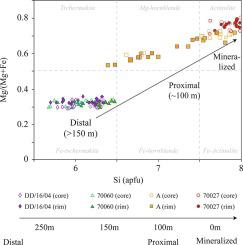当前位置:
X-MOL 学术
›
Ore Geol. Rev.
›
论文详情
Our official English website, www.x-mol.net, welcomes your
feedback! (Note: you will need to create a separate account there.)
Petrogenesis and Geochemical Halos of the Amphibolite Facies, Lower Proterozoic, Kerry Road Volcanogenic Massive Sulfide Deposit, Loch Maree Group, Gairloch, NW Scotland
Ore Geology Reviews ( IF 3.2 ) Pub Date : 2020-09-01 , DOI: 10.1016/j.oregeorev.2020.103623 D.A. Drummond , J. Cloutier , A.J. Boyce , A.R. Prave
Ore Geology Reviews ( IF 3.2 ) Pub Date : 2020-09-01 , DOI: 10.1016/j.oregeorev.2020.103623 D.A. Drummond , J. Cloutier , A.J. Boyce , A.R. Prave

|
Abstract The Palaeoproterozoic Kerry Road deposit is one of the oldest examples of volcanogenic massive sulfide (VMS) mineralization. This small VMS deposit (~500,000 tons grading at 1.2% Cu, 3.5% Zn) is hosted in amphibolite facies mafic-siliciclastic units of the c. 2.0 Ga Loch Maree Group, Scotland. Sulfide mineralization consists of pyrite and pyrrhotite with subordinate chalcopyrite and sphalerite, occurring in disseminated, vein and semi-massive to massive textures. The deposit was highly deformed and metamorphosed during the c. 1.8–1.7 Ga Laxfordian Orogeny. Textural relationships of deformed sulfide minerals, related to early Laxfordian deformation (D1/D2), indicate initial high pressure-low temperature (100 MPa, 150 °C) conditions before reaching peak amphibolite facies metamorphism, as evident from pyrrhotite crossing the brittle/ductile transition prior to chalcopyrite. Late Laxfordian deformation (D3/D4) is marked by local retrograde greenschist facies at low pressure and temperature ( Microprobe analyses of amphiboles record evidence of the original alteration halo associated with the Kerry Road deposit, with a systematic Mg- and Si- enrichment from ferrotschermakite (~150 m) to Mg-hornblende (~90 m) to actinolite (0 m) on approach to the VMS deposit. Furthermore, whole rock geochemistry records a progressive enrichment in Si, Cu, Co, and S, and depletion in Al, Ti, V, Cr, Y and Zr with proximity to the VMS system. These elemental trends, together with amphibole geochemistry, are potentially useful exploration vectors to VMS mineralization in the Loch Maree Group, and in similar highly deformed and metamorphosed terranes elsewhere.
中文翻译:

角闪岩相的岩石成因和地球化学晕,下元古代,Kerry Road 火山大块硫化物矿床,Loch Maree Group,Gairloch,NW Scotland
摘要 古元古代 Kerry Road 矿床是火山成因块状硫化物 (VMS) 矿化最古老的例子之一。这个小型 VMS 矿床(~500,000 吨,品位为 1.2% Cu,3.5% Zn)位于 c. 的角闪岩相基性硅质碎屑单元中。2.0 Ga Loch Maree Group,苏格兰。硫化物矿化由黄铁矿和磁黄铁矿以及次要的黄铜矿和闪锌矿组成,以浸染状、脉状和半块状至块状结构出现。沉积物在 c 期间高度变形和变质。1.8–1.7 Ga Laxfordian 造山运动。变形硫化物矿物的结构关系,与早期拉克斯福德变形 (D1/D2) 相关,表明在达到角闪岩相变质峰值之前的初始高压-低温 (100 MPa, 150 °C) 条件,从磁黄铁矿在黄铜矿之前穿过脆性/韧性转变可以明显看出。Laxfordian 晚期变形 (D3/D4) 以低压和低温下的局部逆行绿片岩相为标志(角闪石的微探针分析记录了与 Kerry Road 矿床相关的原始蚀变晕的证据,具有系统的镁和硅富集来自铁辉绿岩(~150 m) 到 Mg-角闪石 (~90 m) 到阳起石 (0 m) 在接近 VMS 矿床。此外,整个岩石地球化学记录了 Si、Cu、Co 和 S 的逐渐富集,以及 Al 的耗尽, Ti, V, Cr, Y 和 Zr 靠近 VMS 系统。这些元素趋势与闪石地球化学一起,是 Loch Maree Group 中 VMS 矿化的潜在有用的勘探载体,
更新日期:2020-09-01
中文翻译:

角闪岩相的岩石成因和地球化学晕,下元古代,Kerry Road 火山大块硫化物矿床,Loch Maree Group,Gairloch,NW Scotland
摘要 古元古代 Kerry Road 矿床是火山成因块状硫化物 (VMS) 矿化最古老的例子之一。这个小型 VMS 矿床(~500,000 吨,品位为 1.2% Cu,3.5% Zn)位于 c. 的角闪岩相基性硅质碎屑单元中。2.0 Ga Loch Maree Group,苏格兰。硫化物矿化由黄铁矿和磁黄铁矿以及次要的黄铜矿和闪锌矿组成,以浸染状、脉状和半块状至块状结构出现。沉积物在 c 期间高度变形和变质。1.8–1.7 Ga Laxfordian 造山运动。变形硫化物矿物的结构关系,与早期拉克斯福德变形 (D1/D2) 相关,表明在达到角闪岩相变质峰值之前的初始高压-低温 (100 MPa, 150 °C) 条件,从磁黄铁矿在黄铜矿之前穿过脆性/韧性转变可以明显看出。Laxfordian 晚期变形 (D3/D4) 以低压和低温下的局部逆行绿片岩相为标志(角闪石的微探针分析记录了与 Kerry Road 矿床相关的原始蚀变晕的证据,具有系统的镁和硅富集来自铁辉绿岩(~150 m) 到 Mg-角闪石 (~90 m) 到阳起石 (0 m) 在接近 VMS 矿床。此外,整个岩石地球化学记录了 Si、Cu、Co 和 S 的逐渐富集,以及 Al 的耗尽, Ti, V, Cr, Y 和 Zr 靠近 VMS 系统。这些元素趋势与闪石地球化学一起,是 Loch Maree Group 中 VMS 矿化的潜在有用的勘探载体,











































 京公网安备 11010802027423号
京公网安备 11010802027423号